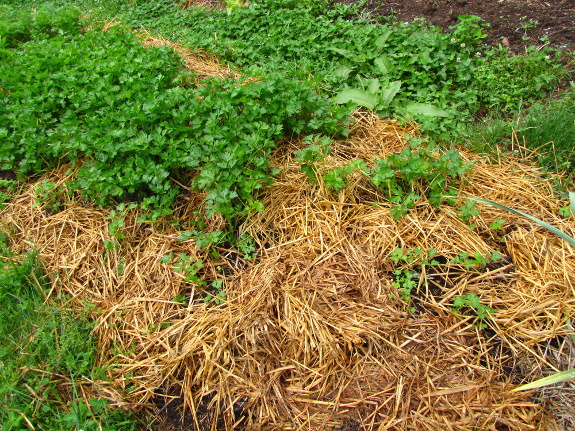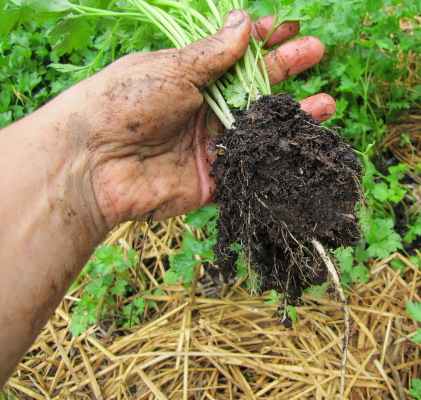
Thinning seedlings (or not)

If you obeyed the
instructions on most seed packets, you'd plant your herbs and
vegetables too thick, then come back through and laboriously thin out
the seedlings that sprouted too close together. I don't do
that. Not only are you throwing your money away when you thin out
seedlings, you also have to either put them somewhere else or endure
the heartbreak of composting a perfectly good plant.
But if you plant your
seeds the proper distance apart from the get-go, you often end up with
patchy germination. (Or, in this case, the cat
scratches up a third of the bed soon after the seeds sprout
and kills them.) My solution is to transplant a few seedlings
from an area where the seeds fell too thickly, using those extras to
fill in empty spaces.
 To be able to transplant
seedlings into those gaps, I do seed a bit thicker than necessary, but
only a little --- not so much that if everyone comes up, they'll be
overcrowded. I'm also careful to transplant when the seedlings
are very young. The parsley plants shown here are really too old
to transplant --- my goal is to be able to scoop up all of the plants'
roots and not disrupt their routine at all when I move them into the
gap.
To be able to transplant
seedlings into those gaps, I do seed a bit thicker than necessary, but
only a little --- not so much that if everyone comes up, they'll be
overcrowded. I'm also careful to transplant when the seedlings
are very young. The parsley plants shown here are really too old
to transplant --- my goal is to be able to scoop up all of the plants'
roots and not disrupt their routine at all when I move them into the
gap.
That said, there are
times that I purposely seed too thickly and thin. Carrots seem to
be a bit problematic to germinate if the soil is hot and dry, so I
often spread the seeds pretty thickly on the soil surface. Once
the roots are just barely big enough to eat --- half an inch in
diameter or less --- I start harvesting the carrots that are too close
to their neighbors, carefully wiggling out dinner without bothering the
keeper plants. That way, I get an extended harvest and ensure
that the main crop of carrots isn't overcrowded as the plants mature.
One final factor to
consider when you're thinking about thinning is the longevity of the
crop. Since we eat our parsley plants for about eleven months,
it's worth making sure they cover the bed well (and something like
asparagus that will feed us for years is even more worthy of
transplanting). But if my lettuce bed is a bit patchy, I just
ignore it --- I'll be ripping out the bed and starting to eat a new
patch of salad greens within a month.
Want more in-depth information? Browse through our books.
Or explore more posts by date or by subject.
About us: Anna Hess and Mark Hamilton spent over a decade living self-sufficiently in the mountains of Virginia before moving north to start over from scratch in the foothills of Ohio. They've experimented with permaculture, no-till gardening, trailersteading, home-based microbusinesses and much more, writing about their adventures in both blogs and books.
Want to be notified when new comments are posted on this page? Click on the RSS button after you add a comment to subscribe to the comment feed, or simply check the box beside "email replies to me" while writing your comment.

First, regarding thinning happy seedlings--I couldn't agree more on all counts. I like your solutions too. Second, and off topic, I came across this article in Grit online today, and immediately thought of you and the hoop houses. Not that you need to do something different this winter, but I figure having ideas stashed away won't hurt, especially if the need for a change arises. they use chicken wire attached to PVC to keep rabbits and dogs out of raised beds (plus plastic sheeting in the winter to extend the harvest) and have used several construction techniques along the way. Thought you and mark might find it useful info. http://www.grit.com/of-mice-mountain-men/garden-fencing.aspx#comments
Have you tried Steve Solomon's suggestion on carrot germination problems? Cook up some corn starch and then cool it in the fridge. Mix in your seed the next day, put in plastic baggie and cut off the corner.
The "gel" keeps the seeds moist during that essential germination period. I'm not thrilled at wasting a baggie but the germination rate, for me, went from almost nothing to 90+ percent.
Worth a shot and some cornstarch if you ask me.
Whoops. I may not have been clear. That's straight seeds that go in the goo, mix the goo/seed ratio and practice a bit to get spacing right. More goo or smaller hole cut in baggie = wider spacing and then plant in place. The cornstarch goo keeps things moist enough for a higher germination rate.